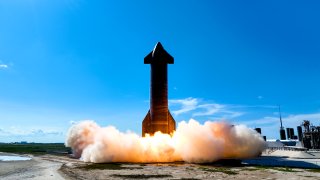
Starship prototype #24 conducts a test firing of six of its Raptor engines at the company’s facility near Brownsville, Texas on Sept. 8, 2022.
- Rob Hauge, president of Northrop Grumman's SpaceLogistics, on Wednesday said SpaceX's "Starship is going to be an awesome capability."
- Still, Hauge said, "We need to see a mature launch vehicle ... Starship is not there yet."
- Northrop Grumman has an agreement with SpaceX to launch robotic spacecraft that extend the life of satellites in orbit.
PARIS — The leader of a Northrop Grumman subsidiary that's working with Elon Musk's SpaceX sees exciting potential in the private space venture's massive Starship rockets, but warned the industry should temper expectations until it hits key milestones.
Northrop Grumman has an agreement with SpaceX to launch robotic spacecraft that extend the life of satellites in orbit. The Northrop unit has twice successfully docked its spacecraft with satellites, and plans to expand the service.
"We're working with SpaceX — Starship is going to be an awesome capability," Rob Hauge, president of Northrop Grumman's SpaceLogistics, said during a panel at the annual World Satellite Business Week conference on Wednesday
Get top local stories in Connecticut delivered to you every morning. Sign up for NBC Connecticut's News Headlines newsletter.
But, speaking to CNBC after the panel, Hauge said that while "Starship will be helpful," SpaceX has yet to reach orbit with a prototype of the rocket.
"There's still a lot of work to do ... we need to see a mature launch vehicle," Hauge told CNBC. "Starship is not there yet."

Hauge's business builds and operates robotic spacecraft known as a Mission Extension Vehicle (MEV). Its customers are companies with satellites in what is known as geosynchronous orbit (GEO).
Money Report
"In order for Starship to get to GEO, they're planning to do refueling of the rocket in orbit ... which hasn't been done yet," Hauge said. "We're going to make sure this capability works, which means all the way down to making sure the rocket we're going to go on is going to work."
SpaceX did not immediately respond to CNBC's request for comment on Hauge's remarks.
Musk's company is working toward the next major milestone in Starship development, conducting a successful flight test into orbit. SpaceX had hoped to conduct the orbital Starship launch as early as last summer, but delays in progress and regulatory approval have pushed back that timeline.
The company is developing the nearly 400-foot-tall Starship rocket with the goal of carrying cargo and people beyond Earth. The rocket and its Super Heavy booster are powered by SpaceX's Raptor series of engines, and the whole system is designed to be reusable.
Musk claims the system could make space travel more like commercial air travel.

